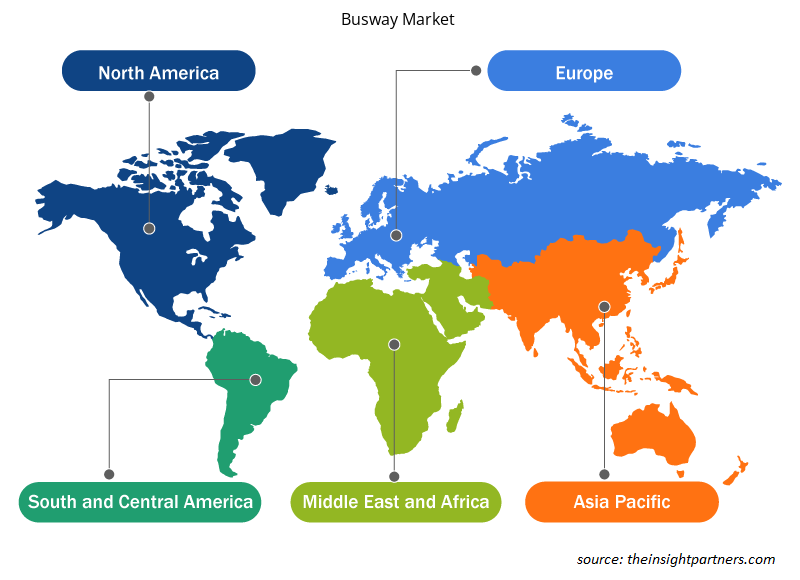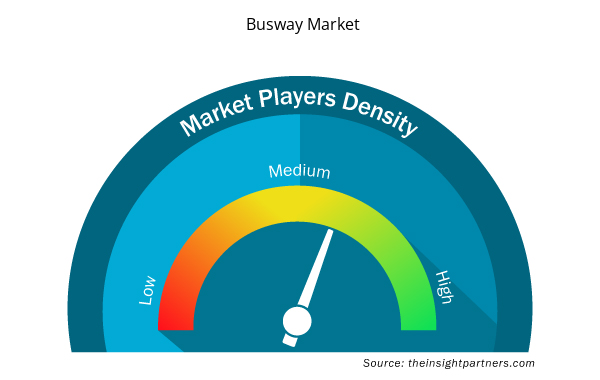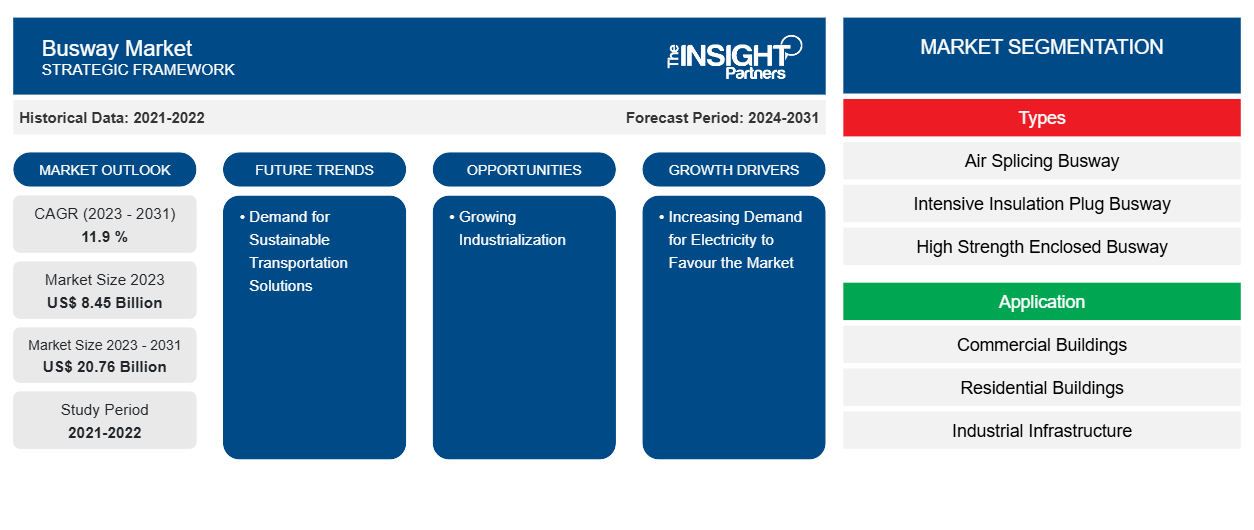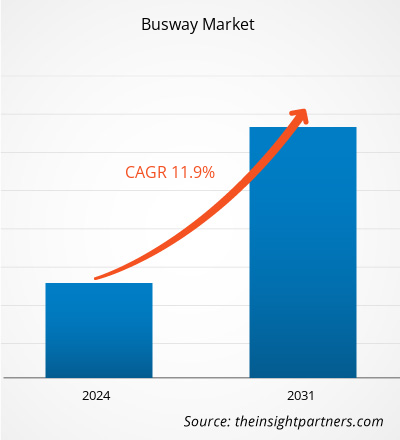Si prevede che la dimensione del mercato delle corsie preferenziali per autobus raggiungerà i 20,76 miliardi di dollari entro il 2031, rispetto agli 8,45 miliardi di dollari del 2023. Si prevede che il mercato registrerà un CAGR dell'11,9% nel 2023-2031. La crescente domanda di elettricità e la crescente industrializzazione rimarranno probabilmente le tendenze chiave del mercato delle corsie preferenziali per autobus.
Analisi di mercato Busway
Si osservano diverse tendenze di crescita in diverse regioni di questo settore. I mercati sviluppati del Nord America (NA) e dell'Europa (ELI) rappresentano una parte significativa della quota di mercato globale; tuttavia, i paesi in via di sviluppo in regioni come Asia Pacifico (APAC), Medio Oriente e Africa (ME), Africa e Sud America (SAM) stanno crescendo rapidamente a causa di una serie di fattori come la necessità di elettrificazione e la crescita di nuove industrie e infrastrutture. Si prevede che l'adozione di Busway aumenterà rapidamente nei prossimi anni a causa dell'espansione delle reti elettriche e dello sviluppo di impianti di energia rinnovabile a livello globale.
Panoramica del mercato Busway
La National Electrical Manufacturers Association (NEMA) definisce una blindo sbarre come un sistema di distribuzione elettrica prefabbricato costituito da tratti rettilinei, raccordi, dispositivi e accessori, tutti racchiusi in un involucro protettivo. Le blindo sbarre trasportano l'energia e la collegano ad apparecchiature elettriche come trasformatori, quadri elettrici e quadri di commutazione . Nelle applicazioni commerciali e industriali, una blindo sbarre è un ottimo sostituto di cavi e condotti perché è più facile da sostituire, meno costosa da installare e richiede meno lavoro di configurazione, specialmente in scenari in cui è probabile che le posizioni del carico varino.
Personalizza questo report in base alle tue esigenze
Riceverai la personalizzazione gratuita di qualsiasi report, comprese parti di questo report, o analisi a livello nazionale, pacchetto dati Excel, oltre a usufruire di grandi offerte e sconti per start-up e università
- Scopri le principali tendenze di mercato in questo rapporto.Questo campione GRATUITO includerà analisi di dati che spaziano dalle tendenze di mercato alle stime e alle previsioni.
Driver e opportunità del mercato delle corsie preferenziali
Aumento della domanda di energia elettrica per favorire il mercato.
L'uso dell'elettricità è aumentato negli ultimi decenni ed è ora essenziale per le economie moderne. A causa dell'aumento del reddito disponibile, si prevede che questa domanda aumenterà nei prossimi anni. L'aumento del consumo di elettricità ha portato a un aumento dell'uso di elettricità nelle industrie degli utenti finali e nelle automobili. Esistono due diversi modelli geografici per la domanda di elettricità. I guadagni di efficienza energetica controbilanciano la crescita futura associata all'aumento dell'elettrificazione e della digitalizzazione nelle economie avanzate.
Crescente industrializzazione
La crescente industrializzazione porta allo sviluppo di nuove fabbriche e impianti di produzione, che necessitano di una solida infrastruttura elettrica per alimentare macchinari e attrezzature, creando una domanda di sistemi di autobus per distribuire l'elettricità in modo efficiente.busway systems to efficiently distribute electricity.
Analisi della segmentazione del rapporto di mercato Busway Market Report Segmentation Analysis
I segmenti chiave che hanno contribuito alla derivazione dell'analisi di mercato delle corsie preferenziali sono tipologie e applicazioni.busway market analysis are types and applications.
- In base alla tipologia, il mercato delle blindo blindate è suddiviso in blindo blindate con giunzione ad aria (BMC), blindo blindate con tappi di isolamento intensivo (CMC), blindo blindate chiuse ad alta resistenza (CFW) e altri.busway market is divided into air splicing busways (BMC), intensive insulation plugs busways (CMC), high-strength enclosed busways (CFW), and others).
- In base all'applicazione, il mercato è segmentato in edifici commerciali, edifici residenziali, infrastrutture industriali e altri.
Analisi della quota di mercato delle corsie preferenziali per area geografica Market Share Analysis by Geography
L'ambito geografico del rapporto sul mercato delle corsie preferenziali è suddiviso principalmente in cinque regioni: Nord America, Asia Pacifico, Europa, Medio Oriente e Africa e Sud America/Sud e Centro America. Il Nord America ha dominato il mercato delle corsie preferenziali. Le tendenze di adozione di tecnologie elevate in vari settori nella regione nordamericana hanno alimentato la crescita del mercato delle corsie preferenziali. Inoltre, una forte enfasi sulla ricerca e sviluppo nelle economie sviluppate degli Stati Uniti e del Canada sta costringendo gli operatori nordamericani a portare sul mercato soluzioni tecnologicamente avanzate. Inoltre, gli Stati Uniti hanno molti operatori del mercato delle corsie preferenziali che si sono sempre più concentrati sullo sviluppo di soluzioni innovative. Tutti questi fattori contribuiscono alla crescita del mercato delle corsie preferenziali nella regione.busway market report is mainly divided into five regions: North America, Asia Pacific, Europe, Middle East & Africa, and South America/South & Central America. North America has dominated the busway market. High technology adoption trends in various industries in the North American region have fuelled the growth of the busway market. Moreover, a strong emphasis on research and development in the developed economies of the US and Canada is forcing the North American players to bring technologically advanced solutions into the market. In addition, the US has many busway market players who have been increasingly focusing on developing innovative solutions. All these factors contribute to the region's growth of the busway market.
Approfondimenti regionali sul mercato Busway
Le tendenze regionali e i fattori che influenzano il Busway Market durante il periodo di previsione sono stati ampiamente spiegati dagli analisti di Insight Partners. Questa sezione discute anche i segmenti e la geografia del Busway Market in Nord America, Europa, Asia Pacifico, Medio Oriente e Africa, e Sud e Centro America.

- Ottieni i dati specifici regionali per il mercato Busway
Ambito del rapporto di mercato Busway
| Attributo del report | Dettagli |
|---|---|
| Dimensioni del mercato nel 2023 | 8,45 miliardi di dollari USA |
| Dimensioni del mercato entro il 2031 | 20,76 miliardi di dollari USA |
| CAGR globale (2023-2031) | 11,9% |
| Dati storici | 2021-2022 |
| Periodo di previsione | 2024-2031 |
| Segmenti coperti | Per tipi
|
| Regioni e Paesi coperti | America del Nord
|
| Leader di mercato e profili aziendali chiave |
|
Densità degli attori del mercato Busway: comprendere il suo impatto sulle dinamiche aziendali
Il mercato Busway Market sta crescendo rapidamente, spinto dalla crescente domanda degli utenti finali dovuta a fattori quali l'evoluzione delle preferenze dei consumatori, i progressi tecnologici e una maggiore consapevolezza dei vantaggi del prodotto. Con l'aumento della domanda, le aziende stanno ampliando le loro offerte, innovando per soddisfare le esigenze dei consumatori e capitalizzando sulle tendenze emergenti, il che alimenta ulteriormente la crescita del mercato.
La densità degli operatori di mercato si riferisce alla distribuzione di aziende o società che operano in un particolare mercato o settore. Indica quanti concorrenti (operatori di mercato) sono presenti in un dato spazio di mercato in relazione alle sue dimensioni o al valore di mercato totale.
Le principali aziende che operano nel mercato Busway sono:
- Schneider elettrico
- Siemens
- Mangiare
- Cavi e sistemi LS
- Spina di alimentazione Busduct Sdn. Bhd.
- ABB
Disclaimer : le aziende elencate sopra non sono classificate secondo un ordine particolare.

- Ottieni una panoramica dei principali attori del mercato Busway
Notizie e sviluppi recenti sul mercato Busway
Il mercato delle corsie riservate agli autobus viene valutato raccogliendo dati qualitativi e quantitativi dopo la ricerca primaria e secondaria, che include importanti pubblicazioni aziendali, dati associativi e database. Di seguito è riportato un elenco degli sviluppi nel mercato:
- Nel giugno 2021, la società di gestione energetica Eaton ha annunciato di aver completato l'acquisizione di una quota del 50 percento nell'attività Busway di Jiangsu YiNeng Electric, che produce e commercializza prodotti Busway in Cina e ha registrato vendite per 60 milioni di dollari nel 2020.
(Fonte: Eaton, Comunicato stampa, 2021)
Copertura e risultati del rapporto sul mercato Busway
Il rapporto "Busway Market Size and Forecast (2021–2031)" fornisce un'analisi dettagliata del mercato che copre le seguenti aree:
- Dimensioni e previsioni del mercato a livello globale, regionale e nazionale per tutti i segmenti di mercato chiave coperti dall'ambito
- Dinamiche di mercato come fattori trainanti, vincoli e opportunità chiave
- Principali tendenze future
- Analisi dettagliata delle cinque forze PEST/Porter e SWOT
- Analisi di mercato globale e regionale che copre le principali tendenze di mercato, i principali attori, le normative e gli sviluppi recenti del mercato
- Analisi del panorama industriale e della concorrenza che copre la concentrazione del mercato, l'analisi della mappa di calore, i principali attori e gli sviluppi recenti
- Profili aziendali dettagliati
- Analisi storica (2 anni), anno base, previsione (7 anni) con CAGR
- Analisi PEST e SWOT
- Valore/volume delle dimensioni del mercato - Globale, regionale, nazionale
- Industria e panorama competitivo
- Set di dati Excel


- Bio-Based Ethylene Market
- Nuclear Decommissioning Services Market
- Rugged Servers Market
- Neurovascular Devices Market
- Mesotherapy Market
- Aircraft Wire and Cable Market
- Skin Tightening Market
- Transdermal Drug Delivery System Market
- Excimer & Femtosecond Ophthalmic Lasers Market
- Asset Integrity Management Market

Report Coverage
Revenue forecast, Company Analysis, Industry landscape, Growth factors, and Trends

Segment Covered
This text is related
to segments covered.

Regional Scope
North America, Europe, Asia Pacific, Middle East & Africa, South & Central America

Country Scope
This text is related
to country scope.
Domande frequenti
The global busway market is expected to reach US$ 20.76 billion by 2031.
The key players holding majority shares in the global busway market are Schneider Electric; Siemens, Eaton, LS Cables, and Systems; and Power Plug Busduct Sdn. Bhd.; ABB; Powerwell; Honeywell International Inc.; Furukawa Electric Co., Ltd.; WOER.
Increasing demand for electricity is the major factors that propel the global busway market.
Growing industrialization, which is anticipated to play a significant role in the global busway market in the coming years.
The global busway market was estimated to be US$ 8.45 billion in 2023 and is expected to grow at a CAGR of 11.9% during the forecast period 2024 - 2031.
Trends and growth analysis reports related to Electronics and Semiconductor : READ MORE..
The Insight Partners performs research in 4 major stages: Data Collection & Secondary Research, Primary Research, Data Analysis and Data Triangulation & Final Review.
- Data Collection and Secondary Research:
As a market research and consulting firm operating from a decade, we have published and advised several client across the globe. First step for any study will start with an assessment of currently available data and insights from existing reports. Further, historical and current market information is collected from Investor Presentations, Annual Reports, SEC Filings, etc., and other information related to company’s performance and market positioning are gathered from Paid Databases (Factiva, Hoovers, and Reuters) and various other publications available in public domain.
Several associations trade associates, technical forums, institutes, societies and organization are accessed to gain technical as well as market related insights through their publications such as research papers, blogs and press releases related to the studies are referred to get cues about the market. Further, white papers, journals, magazines, and other news articles published in last 3 years are scrutinized and analyzed to understand the current market trends.
- Primary Research:
The primarily interview analysis comprise of data obtained from industry participants interview and answers to survey questions gathered by in-house primary team.
For primary research, interviews are conducted with industry experts/CEOs/Marketing Managers/VPs/Subject Matter Experts from both demand and supply side to get a 360-degree view of the market. The primary team conducts several interviews based on the complexity of the markets to understand the various market trends and dynamics which makes research more credible and precise.
A typical research interview fulfils the following functions:
- Provides first-hand information on the market size, market trends, growth trends, competitive landscape, and outlook
- Validates and strengthens in-house secondary research findings
- Develops the analysis team’s expertise and market understanding
Primary research involves email interactions and telephone interviews for each market, category, segment, and sub-segment across geographies. The participants who typically take part in such a process include, but are not limited to:
- Industry participants: VPs, business development managers, market intelligence managers and national sales managers
- Outside experts: Valuation experts, research analysts and key opinion leaders specializing in the electronics and semiconductor industry.
Below is the breakup of our primary respondents by company, designation, and region:

Once we receive the confirmation from primary research sources or primary respondents, we finalize the base year market estimation and forecast the data as per the macroeconomic and microeconomic factors assessed during data collection.
- Data Analysis:
Once data is validated through both secondary as well as primary respondents, we finalize the market estimations by hypothesis formulation and factor analysis at regional and country level.
- Macro-Economic Factor Analysis:
We analyse macroeconomic indicators such the gross domestic product (GDP), increase in the demand for goods and services across industries, technological advancement, regional economic growth, governmental policies, the influence of COVID-19, PEST analysis, and other aspects. This analysis aids in setting benchmarks for various nations/regions and approximating market splits. Additionally, the general trend of the aforementioned components aid in determining the market's development possibilities.
- Country Level Data:
Various factors that are especially aligned to the country are taken into account to determine the market size for a certain area and country, including the presence of vendors, such as headquarters and offices, the country's GDP, demand patterns, and industry growth. To comprehend the market dynamics for the nation, a number of growth variables, inhibitors, application areas, and current market trends are researched. The aforementioned elements aid in determining the country's overall market's growth potential.
- Company Profile:
The “Table of Contents” is formulated by listing and analyzing more than 25 - 30 companies operating in the market ecosystem across geographies. However, we profile only 10 companies as a standard practice in our syndicate reports. These 10 companies comprise leading, emerging, and regional players. Nonetheless, our analysis is not restricted to the 10 listed companies, we also analyze other companies present in the market to develop a holistic view and understand the prevailing trends. The “Company Profiles” section in the report covers key facts, business description, products & services, financial information, SWOT analysis, and key developments. The financial information presented is extracted from the annual reports and official documents of the publicly listed companies. Upon collecting the information for the sections of respective companies, we verify them via various primary sources and then compile the data in respective company profiles. The company level information helps us in deriving the base number as well as in forecasting the market size.
- Developing Base Number:
Aggregation of sales statistics (2020-2022) and macro-economic factor, and other secondary and primary research insights are utilized to arrive at base number and related market shares for 2022. The data gaps are identified in this step and relevant market data is analyzed, collected from paid primary interviews or databases. On finalizing the base year market size, forecasts are developed on the basis of macro-economic, industry and market growth factors and company level analysis.
- Data Triangulation and Final Review:
The market findings and base year market size calculations are validated from supply as well as demand side. Demand side validations are based on macro-economic factor analysis and benchmarks for respective regions and countries. In case of supply side validations, revenues of major companies are estimated (in case not available) based on industry benchmark, approximate number of employees, product portfolio, and primary interviews revenues are gathered. Further revenue from target product/service segment is assessed to avoid overshooting of market statistics. In case of heavy deviations between supply and demand side values, all thes steps are repeated to achieve synchronization.
We follow an iterative model, wherein we share our research findings with Subject Matter Experts (SME’s) and Key Opinion Leaders (KOLs) until consensus view of the market is not formulated – this model negates any drastic deviation in the opinions of experts. Only validated and universally acceptable research findings are quoted in our reports.
We have important check points that we use to validate our research findings – which we call – data triangulation, where we validate the information, we generate from secondary sources with primary interviews and then we re-validate with our internal data bases and Subject matter experts. This comprehensive model enables us to deliver high quality, reliable data in shortest possible time.


 Ottieni un campione gratuito per questo repot
Ottieni un campione gratuito per questo repot